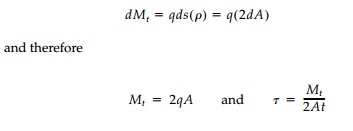Chapter: Civil : Principles of Solid Mechanics : Torsion
Thin Walled Tubes of Arbitrary Shape
Thin Walled
Tubes of Arbitrary Shape
The membrane analogy is
also very useful in analyzing torsion of thin tubes of arbitrary shape with
variable thickness that is ÔÇťsmallÔÇŁ in comparison to the overall dimensions.
Because t is small, the curvature of the membrane


where A is the
area enclosed by the average perimeter. Therefore, the shear stress

and therefore, from a
design standpoint, a circular tube of constant thickness is optimum since it
has the maximum area for a given weight of material to sustain the constant
shear stress.* To determine the angle of twist we can apply, Equation (9.29)

It is important to note
that this analysis, in which we have used the mem-brane analogy can, just as
well, be derived from statics alone. As shown in Figure 9.12, longitudinal
equilibrium of a slice in the z direction requires that

Now taking moments
about any arbitrary point P in the plane of the cross-section:

where A is the
total area enclosed by the cross-section (as in the membrane analogy) and not
the cross-sectional area of the wall of the tube.
Thus the special case
of torsion of a thin tube is statically determinate. As we will see
later, this allows us to use this solution as a building block to generate
lower-bound estimates of the plastic behavior of all sorts of cross-sections in
torsion.
Multicell thin tubes,
which occur in box bridges, aircraft, cars, ships, and skyscrapers can be
analyzed with a simple extension of the single-cell approach and the shear flow
concept. An example with small wall thick-nesses is shown in Figure 9.13. From
the membrane analogy

and the twisting moment
equals twice the volume under the membrane or

From Equation (9.40)
assuming t1, t2, and t3
are constant

Again it should be
noted that Equation (9.43) can, as shown in Figure 9.13, be thought of as the
equilibrium condition at a junction in the longitudinal direction where:

and q = ¤ät is a constant in any branch. This is also the continuity equation for fluid flow in a channel or pipe network stating that the amount of liquid com-ing into a junction must equal that flowing out. Hence the hydrodynamic analogy and the term ÔÇťshear flowÔÇŁ for q.

Related Topics